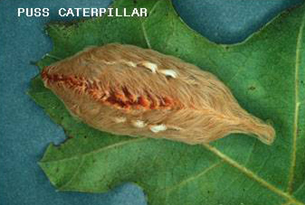Urticating caterpillars give you hives. No, really.
You may recognize the term “hives” as the red, itchy, stinging,
swollen areas of skin that have tortured you or someone you know.
The technical term for hives is urticaria. And a number of things
can cause it.
One cause you probably wouldn’t think of is a caterpillar.
Urticating caterpillars are moth larvae that get their name from
the fact that they sting people in a way that produces urticaria.
These creepy crawlers have hollow spines that hold an irritating
fluid that causes stinging and burning in a person’s skin. In
Georgia, urticating caterpillars show up in the late summer and
fall. The two most common in Georgia are the saddleback and puss
caterpillars.
Saddleback caterpillar
The saddleback (Sibine stimulea) is the one most often
encountered. The full-grown caterpillar is striking. It’s about 1
inch long, and the middle of the body is green with a white or
cream margin and a large, oval, dark brown spot in the center,
also with a white margin. The white-bordered brown spot looks
like a saddle and blanket, giving it its name.
Its startling color scheme doesn’t hide the fact that it bristles
with spines. It has pairs of dark brown, spiny “horns” on the
front and rear ends. And in-between are small clumps of spines
along the lower margin of the green area.
Saddlebacks are generally solitary feeders. However, early-stage
larvae may be somewhat gregarious. They show up in many trees,
shrubs and other plants, including corn. But they’re most common
on oaks, elms, dogwoods and various fruit trees.
Their sting produces an immediate burning
sensation, followed by inflammation, swelling and a red rash.
Puss caterpillar
The puss caterpillar (Megalopyge opercularis) looks a
little like something the cat might have coughed up. It’s hairy.
Really hairy. It’s more than an inch long, with short, toxic
spines hidden underneath its brown or gray fur. The hairs at the
rear end form a tail-like tuft, with the head tucked under the
front.
Puss caterpillars feed on oaks, pecans, persimmon, fruit trees,
roses and other trees and shrubs. They’re typically loners,
although you may find several on a given tree.
These little dusters only look like harmless hair balls. They
actually cause the most painful and severe reaction of any
urticating species in the United States.
When your skin brushes against the puss caterpillar, the spines
break off, releasing an irritating fluid that produces an
immediate stinging, burning sensation. The numbness and swelling
that follow may extend to your whole arm or leg in severe cases.
Red blotches may persist for a couple of days, accompanied by a
weeping rash. Associated lymph nodes may swell and be tender for
12 to 24 hours. Systemic reactions may include nausea and
vomiting.
What to do
If you’re gardening, mowing the lawn, picking fruit or working in
other ways in which you might brush against urticating
caterpillars, wear long pants, long-sleeve shirts and gloves.
If one stings you, treat the symptoms. To remove any spines still
in the skin, gently stick a piece of adhesive tape to the site
and then pull it away. Applying cold compresses can lessen the
pain and swelling.
Over-the-counter pain medications and topical hydrocortisone
creams may help. If the symptoms include systemic reactions or
don’t begin to ease up a couple of days, contact a physician.




